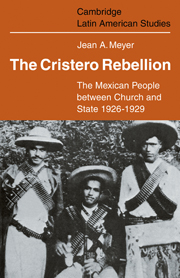
-
Select format
-
- Publisher:
- Cambridge University Press
- Publication date:
- April 2013
- September 1976
- ISBN:
- 9781107300897
- 9780521102056
- Dimensions:
- Weight & Pages:
- Dimensions:
- (216 x 140 mm)
- Weight & Pages:
- 0.35kg, 276 Pages
You may already have access via personal or institutional login
Book description
The Cristero movement is an essential part of the Mexican Revolution. When in 1926 relations between Church and state, old enemies and old partners, eventually broke down, when the churches closed and the liturgy was suspended, Rome, Washington and Mexico, without ever losing their heads, embarked upon a long game of chess. These years were crucial, because they saw the setting up of the contemporary political system. The state established its omnipotence, supported by a bureaucratic apparatus and a strong privileged class. Just at the moment when the state thought that it was finally supreme, at the moment at which it decided to take control of the Church, the Cristero movement arose, a spontaneous mass movement, particularly of peasants, unique in its spread, its duration, and its popular character. For obvious reasons, the existing literature has both denied its reality and slandered it.
Contents
Metrics
Altmetric attention score
Full text views
Full text views help Loading metrics...
Loading metrics...
* Views captured on Cambridge Core between #date#. This data will be updated every 24 hours.
Usage data cannot currently be displayed.
Accessibility standard: Unknown
Why this information is here
This section outlines the accessibility features of this content - including support for screen readers, full keyboard navigation and high-contrast display options. This may not be relevant for you.
Accessibility Information
Accessibility compliance for the PDF of this book is currently unknown and may be updated in the future.


